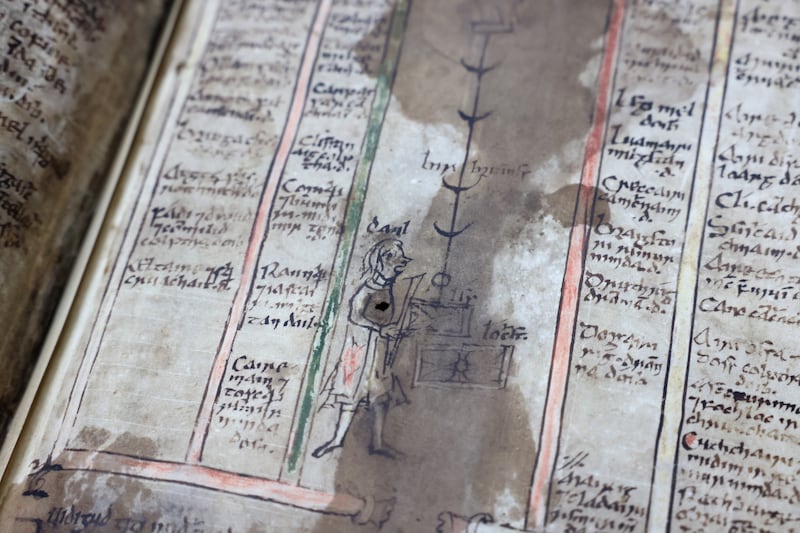Every medieval society had a hierarchy and Irish society before the Anglo-Norman invasion was no different.
A tantalising glimpse of that society is contained in the Book of Leinster, which is to go on public display from Wednesday for the first time since it was fully conserved having been created 900 years ago.
The book contains a diagram of the seating, or more accurately the benching, arrangement in the Teach Miodhchuarta, or Mead Hall, at Tara, with the king in the middle. There is no table, but there is a long spit in the centre. The guests are arranged according to rank, but the diagram shows that poets, musicians and scribes ranked the same as nobles. There is a large image of a jester, and the hierarchy of guests is completed by a detailed account of the cuts of meat – the king getting the best, of course.

The 12th-century, pre-Anglo Norman invasion book, on calf vellum, will be displayed as part of the Book of Kells experience in Trinity College Dublin (TCD).
The book, written in old and middle Irish, was rescued from oblivion by Welsh scholar Edward Lhwyd, who gave it to English aristocrat Sir John Sebright, who in turn presented it to TCD along with other ancient Irish manuscripts in 1786.


It was in a poor state, with staining resulting from techniques used by previous antiquarians.
The book amounts to the “Wikipedia of the age” for Irish scholars, according to the TCD curator of manuscripts and archives, Caoimhe Ní Ghormáin. It contains no less than the origin story of the Irish people and their language. The Lebor Gabála Érenn was an attempt by medieval scholars to establish the place of Ireland, the Irish people and their language in a biblical world setting.
The story of how Breogán built a huge tower in the city of Brigantium (now A Coruña) from which his son first spotted Ireland is so important to the origin myths of Galicia that the page from the Book of Leinster mentioning his name was lent to a museum in Santiago de Compostela.
“Establishing the identity and language of the Irish people was very important at the time that the manuscript was written, which is why the text was produced,” says Ní Ghormáin.

The Book of Leinster was compiled by Áed Ua Crimthainn, who was abbot of the monastery of Tír-Dá-Glas on the Shannon, now Terryglass in Co Tipperary.
It includes a significant version of the famous Irish saga Táin Bó Cúailnge, or the Cattle Raid of Cooley, which is the story of the warrior Cú Chulainn. There is also an account of the siege of Troy.
It has taken two years of conservation, funded by the Bank of America, to get the manuscript into a state that it can go on display, albeit for just three months because exposure to light will degrade the manuscript over time.
Chief manuscript conservator of TCD library Dr John Gillis, who has led the project, said new vellum needed to be found and weak areas reinforced with a form of thin collagen.
He is hopeful that DNA analysis will be able to locate the source of the calf vellum and give a more accurate age for the manuscript.
“It is a privilege to be working with these manuscripts. You can never escape that fact. As a manuscript, it is a unique object. There is no other copy.”


















